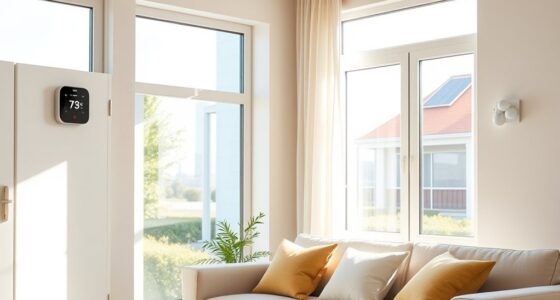By 2025, eco-friendly homes will feature advanced green materials like bamboo, reclaimed wood, and recycled steel for a sustainable footprint. They’ll incorporate renewable energy tech such as seamless solar panels, solar glass windows, and small wind turbines, all integrated seamlessly. Smart systems will optimize energy and water use with sensors and automation, while natural ventilation, green roofs, and living walls improve comfort. If you’re curious about how these innovations come together, there’s more to explore ahead.
Key Takeaways
- Future green homes will extensively use renewable materials like bamboo, reclaimed wood, and recycled steel for sustainable construction.
- Integration of advanced solar windows, rooftop solar panels, and home energy systems will maximize renewable energy use.
- Smart automation will optimize energy and water efficiency through sensors, automated lighting, and climate control systems.
- Water-saving technologies such as rainwater harvesting, greywater recycling, and low-flow fixtures will be standard features.
- Innovative design elements like green roofs, living walls, and natural ventilation will enhance comfort, aesthetics, and environmental harmony.

Are eco-friendly homes the future of sustainable living? As you explore the latest innovations in green housing, you’ll find that they’re designed to minimize environmental impact while maximizing efficiency. At the core of these homes are sustainable materials that reduce reliance on non-renewable resources. You’ll notice that builders are increasingly using bamboo, reclaimed wood, recycled steel, and insulating materials made from natural fibers. These choices not only lower the carbon footprint of construction but also ensure that your home is healthier, free from harmful chemicals common in traditional building supplies.
Eco-friendly homes use sustainable materials like bamboo, reclaimed wood, and recycled steel to reduce environmental impact and promote healthier living.
In addition to eco-friendly materials, renewable energy plays a pivotal role in transforming homes into sustainable havens. Solar panels are now more efficient and sleek, seamlessly integrating into rooftops without compromising aesthetics. You might even find homes equipped with solar glass windows that harness sunlight to generate power while providing natural lighting. Wind turbines, although less common in urban settings, are becoming viable options for rural or suburban properties, offering an additional source of clean energy. These renewable energy systems allow you to generate your own power, drastically reducing or even eliminating your dependence on the grid.
Smart technology further enhances the eco-friendliness of future homes. You’ll have access to advanced sensors and automation systems that optimize energy use throughout the house. For example, smart thermostats adjust temperatures based on occupancy and weather patterns, ensuring you use only what you need. Lighting systems automatically turn off when rooms are unoccupied, conserving electricity. All these features work together to make your home not just environmentally responsible but also more cost-effective in the long run.
Water conservation technologies are also integral to these homes. You might see rainwater harvesting systems that collect and store rainwater for irrigation and non-potable uses. Low-flow fixtures and greywater recycling further reduce water consumption. Additionally, implementing airtight cooler systems can help maintain lower indoor temperatures and reduce energy use for cooling. With these innovations, your home becomes a responsible steward of natural resources, helping to preserve water supplies and lower utility bills.
The design of eco-friendly homes emphasizes not only sustainability but also comfort and aesthetics. Natural ventilation, green roofs, and living walls help regulate indoor temperatures and improve air quality. These homes are built to blend into their surroundings, using eco-friendly landscaping and native plants to promote biodiversity.
In essence, the future of sustainable living is within your reach. With innovative materials, renewable energy sources, and smart technologies, eco-friendly homes of 2025 are more efficient, healthier, and aligned with a greener planet. You don’t have to imagine a better future—you can live in it.
Frequently Asked Questions
What Are the Costs of Building Future Green Homes?
When you’re considering building a green home, a thorough cost analysis helps you understand the expenses involved. You’ll find that initial costs might be higher due to sustainable materials and advanced technology, but budget considerations show potential savings on energy and maintenance long-term. While upfront investments can seem steep, choosing eco-friendly features can boost your home’s value and reduce your carbon footprint, making it a smart and sustainable choice.
How Long Do Eco-Friendly Materials Last?
Ever wondered how long eco-friendly materials last? When you choose sustainable durability, you’re investing in material longevity that can span decades. Many green building materials, like recycled steel or bamboo, are designed to withstand the test of time, often lasting 25 to 50 years or more with proper maintenance. Isn’t it reassuring to know your eco-friendly home can stay beautiful and functional for generations?
Are Green Homes More Resistant to Natural Disasters?
You might wonder if green homes can withstand natural disasters better. They often incorporate sustainable insulation and resilient building techniques, making them more disaster-resilient. These features help absorb shocks, resist flooding, and withstand storms. By focusing on sustainable insulation and durable materials, you’ll find your green home offers enhanced protection, giving you peace of mind during extreme weather events. Overall, green homes tend to be more resistant to natural disasters than traditional houses.
Can Existing Homes Be Retrofitted Sustainably?
Imagine transforming your current home into a sustainable haven. You can retrofit it with renewable energy sources like solar panels and install smart technology to optimize energy use. These upgrades reduce your carbon footprint, lower bills, and increase comfort. Retrofitting is achievable, cost-effective, and impactful, making your home more eco-friendly and resilient. By taking these steps, you actively contribute to a greener future while enjoying modern conveniences today.
What Government Incentives Support Green Home Construction?
You should know that government incentives like rebates and tax credits actively support green home construction. These programs make sustainable building more affordable by offering financial benefits for installing solar panels, energy-efficient appliances, or eco-friendly materials. By taking advantage of these incentives, you can substantially reduce your upfront costs and make your home more environmentally friendly, aligning with future-focused, sustainable living goals.
Conclusion
As you step into 2025, the future of eco-friendly homes promises innovations that could transform how you live—sustainable, smart, and astonishingly efficient. But what secrets still lie hidden behind these cutting-edge designs? Will technology continue to evolve faster than we can imagine? One thing’s for sure: the next chapter in green living is just around the corner, and it’s poised to change everything you thought you knew about home, comfort, and sustainability.









